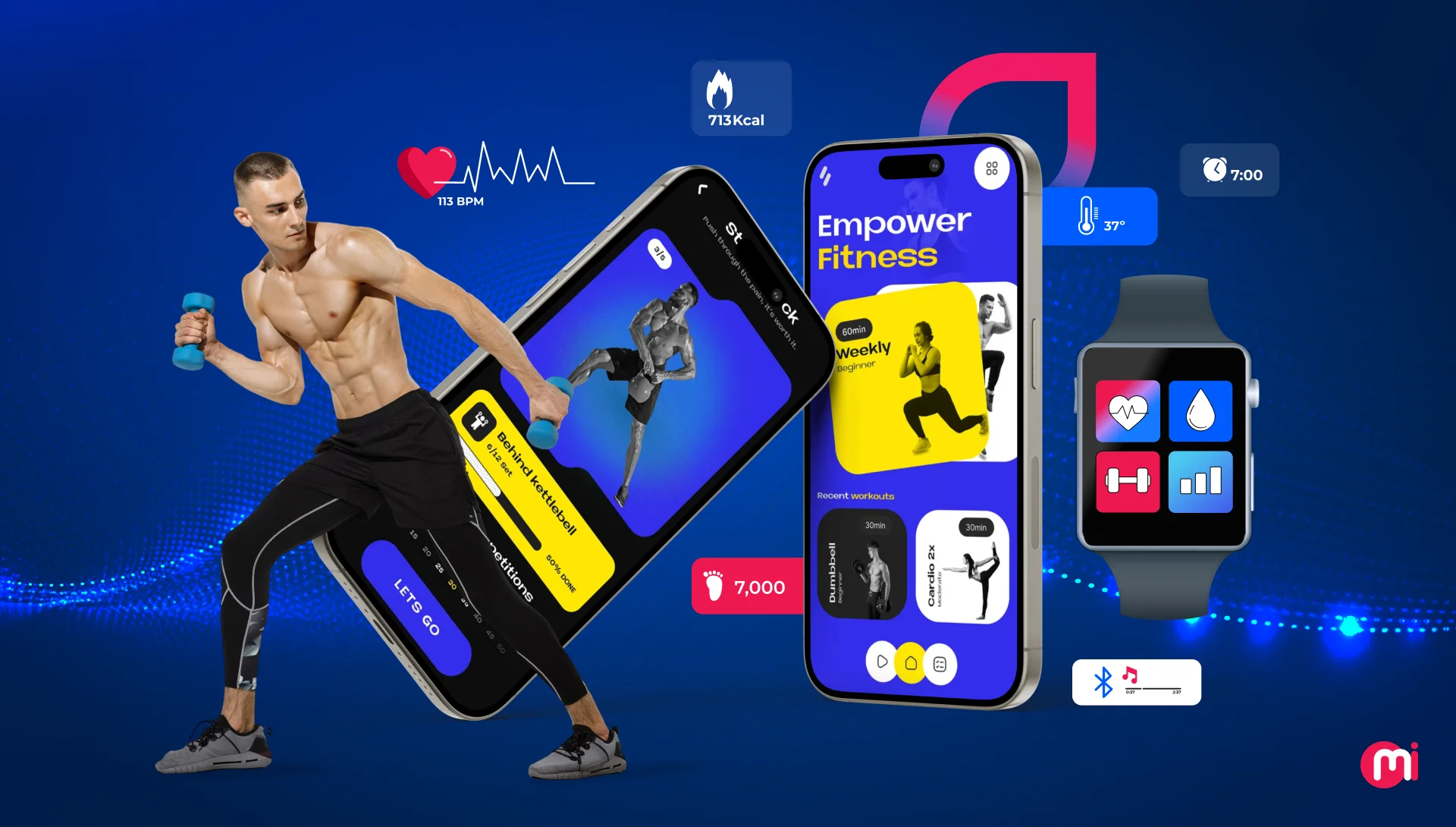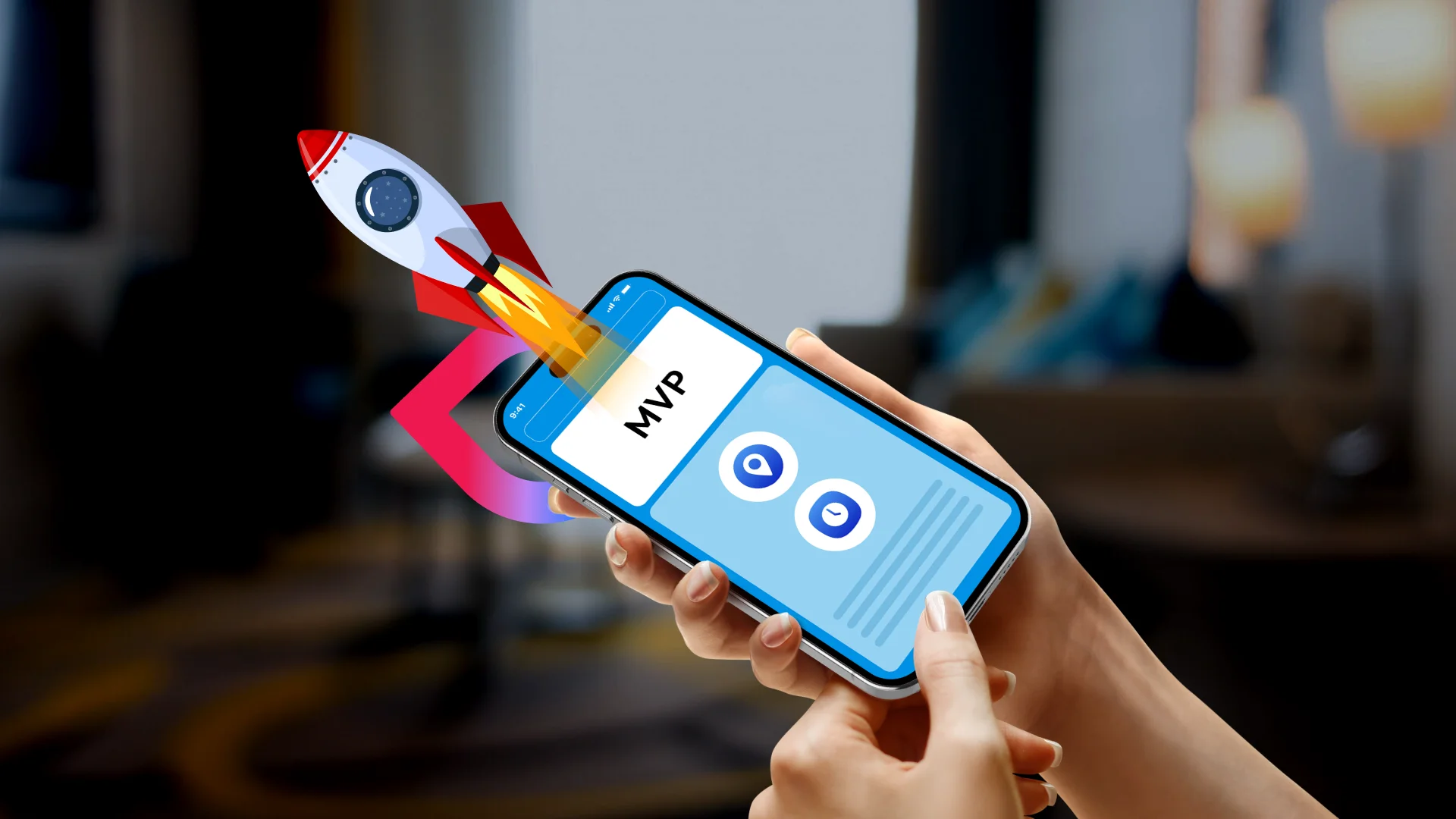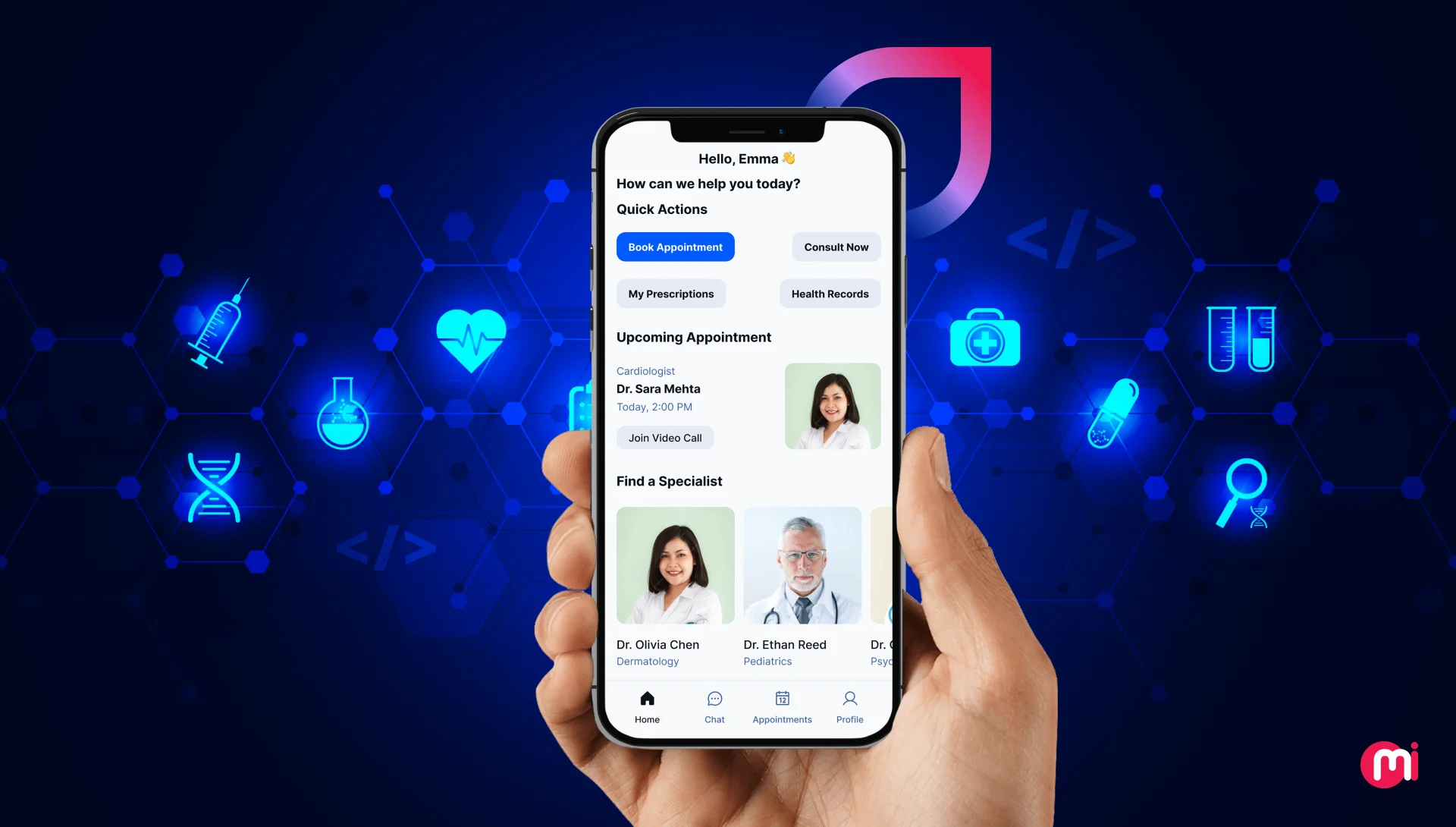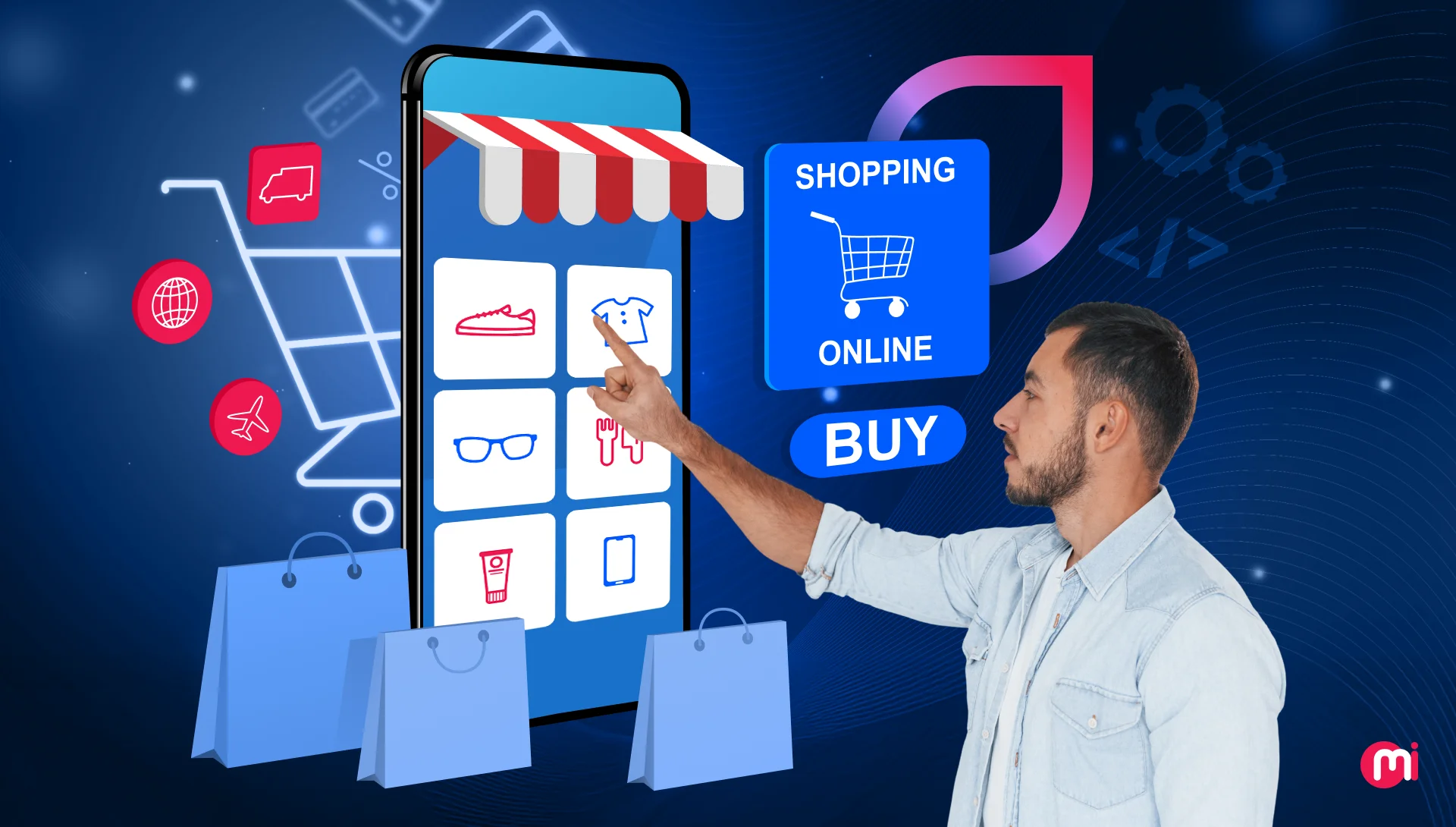Fitness App Development Guide: Exploring Key Features, Workflow, and Cost Insights
- Mobile
- October 8, 2025
Personal health and well-being have never been more prominent than today. The pandemic in 2019 heightened health awareness, and now people are increasingly tracking what they eat, how much they move, and their overall wellness.
This surge in health consciousness has fueled the fitness app market, which generated $3.98 billion in revenue in 2024, experiencing a growth of 11.1% compared to the previous year. For businesses, this growth represents a tangible opportunity to capture a fast-expanding market through strategic investment in fitness app development.
Apps that combine intuitive tracking, personalized plans, and seamless user experiences engage users, generate recurring revenue, and provide actionable consumer insights. However, creating a successful fitness app requires careful planning, thoughtful feature selection, and scalable development strategies.
This guide walks you through how to build a high-impact fitness app, covering essential features, workflow considerations, and cost insights to help your business thrive in 2025 and beyond.
Key Takeaways
- According to McKinsey, 56% of US Gen Z prioritize fitness, reflecting a growing, engaged user base for digital wellness apps.
- From exercise and nutrition to activity tracking, understanding app categories enables strategic positioning.
- Intuitive tracking, personalized plans, analytics, and community features leveraging AI and wearable integrations boost retention and differentiation.
- Fitness app development requires an investment of $30K–$200K+, depending on complexity and integrations.
Fitness App: Market Overview and Industry Insights
According to Grand View Research, the global fitness app market was valued at USD 10.59 billion in 2024 and is projected to reach USD 23.21 billion by 2030, growing at a CAGR of 13.88% from 2025 to 2030.
Business of Apps reveals that in 2024, 345 million people used fitness apps, with a total of 850 million downloads recorded worldwide. This rapid growth reflects the rising consumer focus on health, wellness, and personalized fitness solutions worldwide.
Key Market Trends & Insights
Regional Dominance: North America led the global fitness app market in 2024, accounting for 46.61% of total revenue, with the U.S. holding a significant share within the region.
Market Segmentation by Type: According to Future Marketing Insights, the Exercise & Weight Loss segment, it is expected to grow at a CAGR of 12.5% between 2025 and 2035, while the Activity Tracking segment is projected to expand at 14.9% over the same period.
User Engagement: Recent reports given by Technavio indicate that over 70% of fitness app users interact with their apps daily, and the industry is projected to grow at an annual rate of 20%.
Platform Insights: By platform, iOS led with 52.13% market share in 2024. However, the Android platform maintained dominance globally due to affordability, widespread smartphone adoption, and accessibility, particularly in developing markets.
Device Preferences: Smartphones were the preferred device for fitness apps, accounting for 66.91% of usage, underscoring mobile-first engagement trends.
Emerging Markets: The Asia Pacific region, led by India, is expected to witness rapid growth, driven by urbanization, rising disposable income, expanding internet penetration, and a digitally active young population.
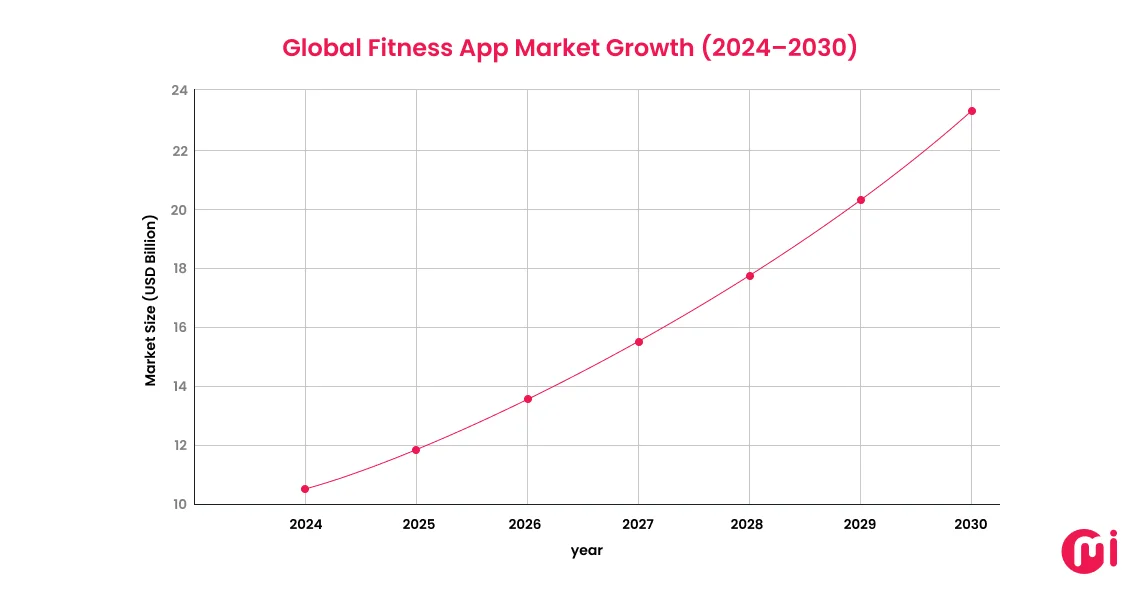
What are the Types of Fitness Apps?
The types of fitness apps include workout and exercise apps, nutrition and diet apps, activity tracking apps, yoga apps, social fitness apps, meditation and mindfulness apps, fitness studio apps, specialized fitness apps, personal trainer apps, and mood tracking apps.
Each category is designed to address different aspects of health and wellness, offering users personalized tools and experiences to support their fitness journey and overall well-being. Explore these best fitness app types in detail:
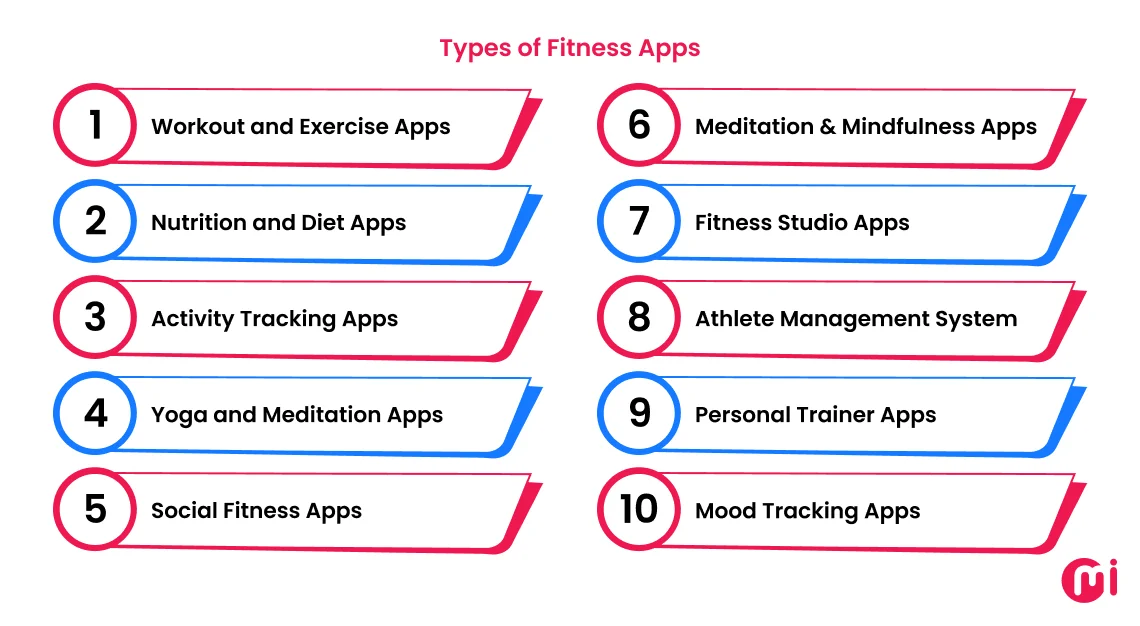
1. Workout and Exercise Apps
Workout and exercise apps offer structured workouts and exercise routines, complete with video tutorials, customizable plans, and progress tracking to build strength, endurance, and overall fitness.
Real-Life Example: Nike Training Club, one of the best fitness apps that offers guided workout plans for strength, endurance, and mobility. Users can follow video instructions and track progress across various fitness levels.
2. Nutrition and Diet Apps
They help users monitor meals, calories, and macronutrients while providing personalized recommendations and meal plans to support diet and fitness goals.
Real-Life Example: Passio.AI, an AI-driven nutrition tracking platform that personalizes diet management, monitors nutrient intake, and provides actionable insights to help users achieve their health and fitness goals.
3. Activity Tracking Apps
Such apps provide real-time insights by logging steps, distance, calories burned, and heart rate, often syncing with wearable devices for comprehensive tracking.
Real-Life Example: Fitbit, an activity & wearable tracking app that tracks steps, workouts, heart rate, sleep, and overall daily activity.
4. Yoga Apps
These platforms focus on improving flexibility, mindfulness, and relaxation through guided yoga sessions, breathing exercises, and wellness practices.
Real-Life Example: Yoga for Beginners, a yoga app that provides guided yoga sessions, structured workout plans, instructional videos, and customizable routines to reduce stress, improve sleep, and enhance mental well-being.
5. Social Fitness Apps
They connect users with friends or larger communities, fostering motivation through challenges, shared achievements, and social accountability.
Real-Life Example: Strava enables runners, cyclists, and other athletes to track workouts, share progress with friends, join challenges, and engage with a community for motivation.
6. Meditation & Mindfulness Apps
Designed to enhance mental well-being, these apps provide structured meditation routines, stress-relief exercises, and mindfulness techniques for emotional balance.
Real-Life Example: Headspace focuses on mindfulness practices and meditation techniques to help users manage stress, improve focus, and foster emotional well-being.
7. Fitness Studio Apps
They allow gym or studio members to book classes, access on-demand workouts, track attendance, and interact with instructors, making workouts more convenient and engaging.
Real-Life Example: ClassPass allows users to book workouts, classes, or personal training sessions at various gyms and studios, offering flexibility and access to multiple fitness experiences.
8. Athlete Management System
The system caters to professional and amateur athletes, consolidating health, performance, and training data in one platform. It offers personalized monitoring, progress tracking, and expert insights to optimize performance and ensure overall well-being.
Real-Life Example: SAM ™, a centralized Athlete Management System designed to consolidate all relevant data, allowing teams to effectively monitor athletes’ health and optimize their performance.
9. Personal Trainer Apps
They bring one-on-one coaching to users through customized workout plans, real-time feedback, and progress monitoring, simulating in-person training sessions.
Real-Life Example: 6PP, a personal trainer app offering programs from Jeff Cavaliere, MSPT & CSCS. Train with one of the world’s top experts in science-based performance and coaching.

Essential Features for Successful Fitness App
To build a fitness app, it’s essential to consider a range of features categorized as basic, intermediate, and advanced. Each level of functionality is designed to enhance user engagement, support personalized fitness journeys, and provide scalable solutions for growth.
From foundational tools to sophisticated capabilities, these features collectively ensure a well-rounded and effective fitness app experience. Take a detailed look at these features:
Basic Features
| Feature | Description |
| User Registration | Secure and simple sign-up to get users started instantly. |
| User Profile Management | Personalized profiles to track fitness goals and preferences. |
| Pre-designed Workout Routines | Ready-to-use workout plans for all fitness levels. |
| Activity Tracking | Monitor workouts, steps, and calories in real time. |
| Push Notifications and Reminders | Timely alerts to keep users consistent and motivated. |
| Basic Progress Visualization | Quick visual insights on workouts, goals, and improvements. |
| Social Media Integrations | Share achievements and connect with friends for motivation. |
| Payment Integrations | Enable in-app purchases, subscriptions, or premium features effortlessly. |
Intermediate Features
| Feature | Description |
| Custom Workout Builder | Create personalized workouts tailored to individual goals and fitness levels. |
| Video Tutorials | Step-by-step exercise videos for correct form and guidance. |
| Meal Planning and Calorie Tracking | Plan meals and track calories to meet nutrition and fitness goals. |
| Wearable Devices Integrations | Sync data from smartwatches and fitness trackers for seamless tracking. |
| Goal Setting and Milestone Tracking | Set targets and monitor progress with achievable milestones. |
Advanced Features
| Feature | Description |
| AI-Driven Personalized Workout & Nutrition Plans | Offers intelligent recommendations tailored to individual goals and habits. |
| Virtual Coaching & Real-time Feedback | Provides real-time guidance and corrections for workouts from virtual coaches. |
| AR/VR Immersive Workouts | Engaging in augmented or virtual reality workouts for interactive training. |
| Geolocation Integrations | Track outdoor activities and map running, cycling, or hiking routes. |
| Advanced Analytics | In-depth insights into performance, trends, and areas for improvement. |
| Gamification | Achievements, badges, and challenges to boost motivation and engagement. |
| Offline Access & Syncing | Access workouts and logs without the internet, with automatic syncing later. |
| Integration with Advanced Sensors | Use heart rate monitors, smart scales, and other sensors for precise data. |
| Premium Content Library | Exclusive workouts, recipes, and tutorials for premium users. |

How to Create a Fitness App: Step-by-Step Process
To create a fitness app, you must first conduct market research, define your app’s purpose and core features, and design the app. You should also map the user journey and plan engagement strategies to ensure long-term retention.
After that, develop the app, integrate features such as progress tracking and wearable support, rigorously test it, and launch while continuously gathering user feedback for updates and improvements. Here is a detailed description of each step:
1. Software Discovery
To start the project, identify your purpose, target audience, and the core problems your app will solve. The software discovery phase is about setting a clear vision, researching competitors, defining the must-have app features, and choosing fitness app development technologies.
Define a clear MVP roadmap so you know exactly which features to prioritize first, where to focus resources, and how to move faster toward launch without wasting time or budget.
2. App Design
Design the user experience, define user flows, and create wireframes that map the journey, then refine them into high-fidelity UI designs. Focus on creating an interface that feels intuitive, accessible, and aligned with your brand. Build an app prototype and test it with sample users to ensure that the design works in practice.
3. App Development
Develop your app in iterative sprints using Agile or other software development methodologies that match your project requirements. Develop the frontend interface, backend systems, databases, and APIs while integrating wearables, payment solutions, or fitness platforms like Apple HealthKit or Google Fit. Structure the development in a modular way to simplify future updates, scaling, and feature additions.
4. QA Testing
Perform thorough QA testing across all devices and operating systems. This includes functional testing, performance checks, usability reviews, and security audits to ensure the app works flawlessly. Running a beta release with real users during QA testing helps identify issues and edge cases that might not appear in controlled environments, ensuring a smoother, more reliable launch.
5. App Deployment
After testing, prepare your app for launch. Set up app store listings, privacy policies, and compliance requirements while submitting your app for review. Use staged rollouts and monitoring tools to track performance, stability, and user engagement during the initial release.
6. Proactive Maintenance
After launch, follow a proactive approach for software maintenance to keep your app stable, secure, and engaging. Continuously release updates, fix bugs, and apply security patches while closely monitoring user feedback and analytics.
Use these insights to enhance existing features, add new functionality, and optimize the user experience, ensuring your app stays competitive and continues to meet evolving fitness needs.
How Much Does It Cost to Develop a Fitness App in 2025?
The fitness app development cost starts from $30,000 and can reach up to $200,000+.
However, costs can vary widely depending on the app’s complexity, features, and development approach, making it essential to plan carefully.
Fitness App Development Cost Estimates
| App Type | Estimated Cost |
| Basic App (MVP) | ($30K–$45K+) |
| Medium Complexity App | ($45K–$60K+) |
| Advanced App | ($60K–$90K+) |
| Premium App with AI & VR | ($90K–$200K+) |
Cost-Saving Strategies
- Develop an MVP that focuses on core features to test the market before investing in advanced functionalities.
- Use frameworks like Flutter or React Native for cross-platform app development.
- Outsource software development projects to regions with skilled developers at competitive rates.
- Leverage existing platforms or white-label digital solutions to reduce software development time and cost.
- Developing a fitness app in India or globally can be cost-effective if you plan strategically, prioritize features, and leverage modern development tools.
Final Thoughts
Fitness apps define a company’s role in the digital wellness revolution rather than just being a product decision. Intelligent features, adaptive workflows, and actionable insights transform user interactions into measurable business outcomes.
Forward-thinking businesses should leverage these platforms to innovate, lead markets, and create lasting influence. Every investment in a well-designed app can become a catalyst for growth, differentiation, and long-term impact.
Build Your High-End Fitness App with MindInventory
MindInventory is a reputed fitness app development company, renowned for delivering innovative and scalable digital solutions tailored to the dynamic fitness industry. With a robust portfolio encompassing personalized workout apps, gym management systems, and wellness platforms, we have consistently demonstrated our expertise in creating user-centric applications that drive engagement and promote healthier lifestyles.
We utilize emerging technologies, including Kotlin, Swift, React Native, and Flutter for responsive mobile development; Node.js, Python, and Laravel for robust backend solutions, etc. We have partnered with cloud platforms like AWS and Google Cloud to build scalable and reliable infrastructure. Our applications support integration with wearable devices, enabling real-time tracking of health metrics and activity data.
MindInventory’s dedication to quality and security is reflected in its adherence to global standards and certifications, including ISO 9001:2015 for quality management, ISO 27001:2022 for information security, SOC 2 Type II for operational controls, and HIPAA compliance for handling sensitive health information. These credentials ensure that every app delivered is secure, reliable, and compliant with industry best practices.
Beyond technology, MindInventory offers tailored fitness software development solutions for various segments of the fitness industry. We build custom apps for gyms, personal trainers, and businesses operating in the segment. Our solutions drive engagement and redefine digital wellness experiences.

FAQs on Fitness App Development
Fitness app development is the process of building an application that helps users track workouts, monitor health data, plan meals, and achieve wellness goals. Modern fitness apps integrate intuitive design, smart data management, wearable connectivity, and advanced technologies like AI, AR, or VR to create personalized and engaging wellness experiences.
You can monetize fitness apps in several ways, including subscription plans, in-app purchases for premium workouts or diet programs, advertising, and partnerships with gyms or wellness brands. Many apps also follow a freemium model, offering core features for free while charging for advanced tools and personalized plans.
The best fitness apps are MyFitnessPal, Strava, Fitbod, Nike Training Club, etc. These apps stand out due to their rich features, including activity tracking, nutrition logging, AI coaching, and strong community engagement.
Development time typically ranges from 6 months to 9 months+ for a basic app (MVP), 9–12 months+ for a mid-level app, and 1 to 3 years+ for a full-featured advanced app with AI, wearables integration, or AR/VR workouts. However, the final timeline depends on project requirements, tech stack, complexity, team size, and other significant aspects.
A strong tech stack for fitness apps has tools for every layer, including React Native or Flutter for cross-platform development, Node.js or Python for backend, MongoDB or PostgreSQL for databases, and integrations with Apple HealthKit, Google Fit, and Fitbit APIs. For AI-driven features, frameworks like TensorFlow or PyTorch work best.
Fitness apps offer many benefits, including expanding into the booming health and wellness market, creating recurring revenue opportunities, building brand loyalty, and providing users with accessible tools to stay healthy. They also use data-driven insights to deliver personalized experiences that keep users engaged.
Fitness app development challenges include designing a user-friendly interface, ensuring accurate activity tracking and seamless wearable device integration, and maintaining strong data security and privacy. It also involves providing meaningful personalized experiences, supporting performance and scalability, achieving cross-platform compatibility, and managing complex monetization strategies.
Future trends in fitness apps include advanced AI-driven personalization for workouts and nutrition and more seamless integration with wearables for real-time health and wellness monitoring. Other key trends involve immersive AR/VR experiences, enhanced community and social engagement through gamified challenges, and a stronger emphasis on holistic well-being, including mental health, mindfulness, and stress management.
Fitness apps handling health data must comply with HIPAA (US), PCI DSS, GDPR (EU), and other regional privacy laws. Key practices include end-to-end encryption, secure APIs, role-based access, and regular audits to protect sensitive user health information.
